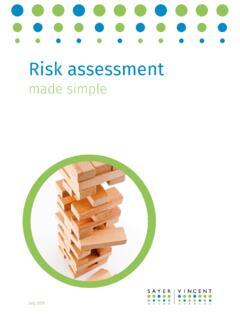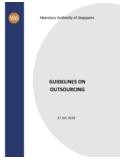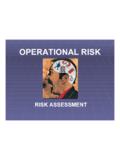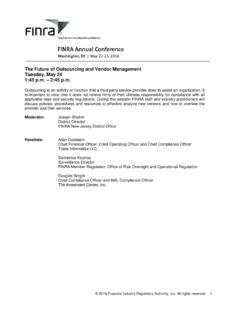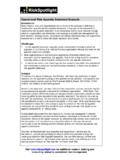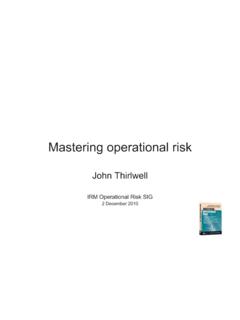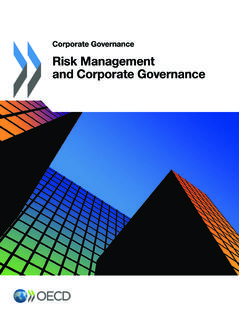Transcription of Risk management - Sayer Vincent
1 1 Risk managementmade simpleJuly 2015 Risk management made simple2 Sayer Vincent LLP Chartered accountants and statutory auditors Invicta House 108 114 Golden Lane London EC1Y 0TL Offices in London, Bristol and Birmingham 020 7841 @sayervincent Published by Sayer Vincent LLP Chartered accountants and statutory auditors Limited liability partnership registered in England and Wales OC390403 Copyright Sayer Vincent All rights reserved No part of this publication may be reproduced by any means, or transmitted, or translated into a machine language without prior permission in writing from the publisher. Full acknowledgement of the author and source must be Vincent shall not be liable for loss or damage arising out of or in connection with the use of this publication. This is a comprehensive limitation of liability that applies to all damages of any kind, including, (without limitation), compensatory, direct, indirect or consequential damages, loss of data, income or profit, loss of or damage to property and claims of third parties.
2 management made simple3 Introduction 5 Step 1 Decide to become a risk-enabled organisation 6 Step 2 Clarify the types of risks to consider 8 Step 3 Establish an organisation-wide risk policy 9 Step 4 Implement operational risk management 11 Step 5 Rank the effectiveness of controls and actions to manage risk 14 Step 6 Identify strategic risks 17 Conclusion 19 Further information 20 Notes 21 Risk management made simple4 Risk management made simple5 IntroductionA simple process for identifying and ranking risks is described in Risk assessment made simple. After a time, this can become a tick box exercise and lose its effectiveness. In addition, there are some drawbacks to listing risks which are described to listing risks Definition of the risk a risk can only be ranked if you have precisely defined the nature and extent of the risk, so vague descriptions are incapable of measurement.
3 To overcome this problem, the list of risks is often extended, as you attempt to cover the full range of possibilities. Numbers-based ranking is misleading people are often misled into thinking this is a scientific method and that the ranking is true , whereas it is really just an expression of perceptions. One person s view of what is high risk is different to the next person s view, so you may not be talking the same language. This approach feeds the misapprehension that risk management is about identifying all the risks and then controlling them. In reality, it is not possible to identify all risks and risk management is not about controlling or eliminating risk. The actions identified to mitigate the risks do not always properly respond to the risk. The control or mitigation may not actually be effective or properly fact, risk management can be focused on the strategy and used to help managers consider how they may enhance their chances of success with plans and projects.
4 Constructive use of risk management techniques can draw out the positive management responses available to an organisation and develop the capacity of individuals to manage risks more management made simple6 Step 1 Decide to become a risk-enabled organisationThe Institute of Internal Auditors has described the stages of risk maturity for organisations, with risk enabled as the top level. At this level, the organisation is using risk management processes to improve performance and decision-making. Discussions about risks take place as part of the planning processes and regular performance monitoring and risk assessment is not a separate activity. Trustees, managers and staff understand the levels of risk they are responsible for managing and report upwards when they notice a change in the ranking of a risk or risk management process needs to be led by the trustees and senior management team, but it needs to be clear that operational managers have their role to play and are responsible for managing risks as part of their job.
5 It is usual to have an annual process in place for operational managers to report on how they manage risks . Note that the emphasis is on managing risk, so the process focuses on actions to control the first step is to be clear about who is responsible for different types of naiveRisk awareRisk definedRisk managedRisk enabledNo formal approach developed for risk managementSome risks reviewed but infrequentlyRegular reviews of risks ; significant new projects reviewed for riskProcess established, risk reported upwards where high net riskManagers responsible for effectiveness of risk managementRisk management made simple7 Assigning responsibility for managing and reviewing riskStrategicOperationalKnownUnknownStra tegic and identified risksDeal with through the usual planning mechanisms, reporting to Audit CommitteeOperational and identified risksDeal through normal management policies and procedures should cover the controls neededStrategic and uncertain risksRegister and manage at Audit Committee level, reporting to every Board meetingOperational and uncertainRegister and manage at Senior Manager level.
6 Reporting to Audit CommitteeRisk management made simple8 Step 2 Clarify the types of risks to considerThe main types of risks to consider are project, strategic and operational risks . These are different and require different documentation and risksThese are risks arising from a particular programme or project and should be managed as part of the governance for that activity, regularly reviewed and monitored. This is part of good project governance and risksThe majority of operational risks are internal risks and predictable, therefore you can do something to reduce their likelihood and occurrence. You then need to ensure that the management actions are actually implemented and are the operational risks can result in very long lists of all the things you have to manage day-to-day and are often covered by procedures.
7 It is therefore pointless and repetitive to list every risk, noting the action to control the risk as an existing procedure. It is more useful to accept that many of the operational risks are fairly obvious and are part of day-to-day management . Strategic risksThese are likely to be the big issues such as reputational risk, or the risk that the organisation may fail to deliver on a major strategic aim. They are also likely to be external events with high impact which you cannot control and therefore you have to consider how you will respond to them if they happen. A good risk assessment process will analyse these risks to get to the root cause and then consider appropriate management responses. It is harder to assign specific responsibility for strategic risks as they are likely to be very high impact or pervade all parts of the organisation, although it is possible to assign mitigating actions.
8 Risk management made simple9 Step 3 Establish an organisation-wide risk policyAny risk register or statement about risk is meaningless unless there is a clear context set out in a risk policy. As an organisation, you need to have a common understanding about the activities where you wish to be risk-taking and the areas where you clearly wish to be risk averse. For example, a charity may wish to take risks with some grant-making activities, but be averse to taking risks on its investment portfolio. Trustees and managers need to establish the organisation s attitude to risk in various situations so that personal preferences may be put aside in favour of a collective organisations need to take risks , and a risk management policy should describe where the organisation wishes to take risks as well as where risk should be avoided.
9 In fact, there are a range of responses available to an organisation and the appropriate response will depend on the nature and level of the risk and whether the concern is that it has a high impact and/or high to risks You can accept the risk this may be after controls have been put in place to manage some risk, leaving a residual risk which you are prepared to accept. You can transfer the risk this is achieved when you take out insurance cover as now a third party will be liable for the full costs because you are paying a premium. This may also be achieved in some cases of outsourcing if the contract specifies the transfer of risk. You can develop a response plan to mitigate the effects of an external risk. This is appropriate in situations where you do not have control over the event (such as bad weather, or a power failure) but you can plan ahead to ensure that the organisation can respond more effectively.
10 You can take action to minimise the likelihood that adverse events will happen, for example, that performance will fall short of expectations or that we lose money through poor practice. This is relevant for many operational risks where the risk is internal and under our control. For example, you risk losing data, but can minimise the likelihood of this happening by having good back-up procedures. You can avoid an activity altogether if you judge the risks to be too high. For example, you can decide not to take any money from governments to avoid the risk that you will be identified as supporting government management made simple10 Once you have established an organisational risk policy, this can provide the context for assessing risks at all levels. The risk policy also feeds into the investment policy and the reserves policy, as well as other aspects of financial strategy, such as the pricing risk policyABC Charity works with people who have been disadvantaged through limiting life chances when young.
